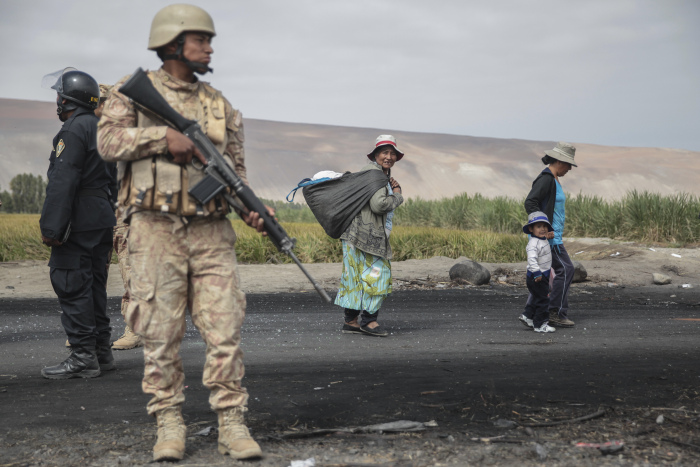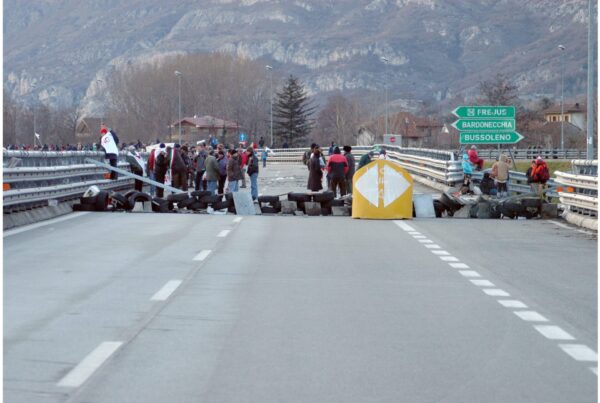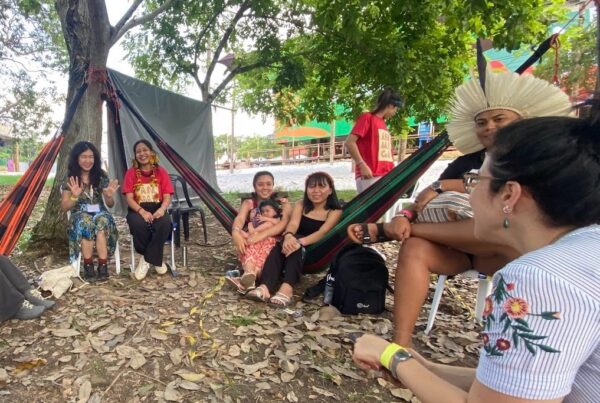By Alexander Dunlap
The Peruvian state is laying military siege to enforce extraction operations; ironically, land defenders are the ones branded as terrorists.
Today, nearly all opposition to resource extraction is branded as terrorism. In the context of growing extractivism, the Peruvian state has generously expanded the definition of “terrorism”. Simultaneously, it has blurred the line between the public and private security sector, with Law No. 30151 that exempts members of the armed forces and Peruvian National Police (PNP) from criminal responsibility when they cause injury or death.
Legislation legitimizing the repression and murder of land defenders by security forces arises after the Battle at “Devil’s Curve” in Bagua, on 5 June 2009. In Bagua, at least 32 people were killed—22 from the invading security forces—and hundreds injured when Indigenous land defenders refused to permit oil exploration in the Amazon. President Alan García (2006-2011) referred to the land defenders as “anti-democratic” and “terrorists” in an attempt to justify and recast state violence.
García then passed a decree allowing resource extraction companies to contract, according to Grufides Human Rights, “the provision of extraordinary additional services by the Police” that encouraged the military and the National Peruvian Police (PNP) to draft private-public security partnerships “to ‘prevent, detect and neutralise’ threats by means of precautionary measures, surveillance and patrols.”
“Threats” are recognized as “civil war, invasion, insurgency, strikes, internal unrest, civil disturbances, rebellion, vandalism and other criminal and terrorist action.” Violent repression and branding mining opposition as “terrorist” would strike the agrarian Tambo Valley over the Tía Maria mine located in southwest, Peru.

The Tía María mining project in the Tambo Valley, Peru. Source: Ministry of Energy and Mining.
The Tía Maria Conflict exemplifies the self-serving politico-military strategies deployed to impose an extractivist-oriented development model, bent on both marginalizing land defenders and ignoring the issues of ecological and climate crisis. Southern Copper Peru or Southern, a subsidiary of the firm Grupo Mexico, has sought to extract 120 thousand tons of copper cathodes (and other metals, including gold) in the Tambo Valley per year for 18 years with a 1.4 billion dollar investment.
The Tía Maria Conflict began in August 2009. Rioting erupted during the consultation process, after Southern preferred to use ground and river water instead of building a desalination plant to use sea water. In October that year, a popular consultation (consulta popular) was called in the Tambo Valley, resulting in 93.4% rejection of the Tía Maria project. This led to repeated negotiations and the summoning of the United Nations Office of Project Services (UNOPs), who eventually made 138 observations against the project.
Government support for the project led to popular mobilizations, which included general strikes and road blockades. In 2011, over 2,000 national police flooded the area to clear the road blockades. This turned to riots, eventually resulting in the deaths of Adrés Taipe Chuquipuma on April 4th, followed by Néstor Cerezo Patana, Aurelio Huarcapuma Clemente and Miguel Ángel three days later.
Subsequently, Southern claimed to make changes and comply with the UNOPs observations, which included constructing the desalination plant. Southern would also initiate a comprehensive public relations campaign at the local, regional and national level. Southern’s claim, however, remained rightfully contested by local officials and civil society groups protesting and blocking roads.
Julio Morriberón, Southern’s head of “community relations,” declared on March 27th, 2015 the retirement of the Tía Maria project, because first, “the onslaught of a new type of terrorism, anti-mining terrorism” and “secondly, the paralysis of the state in its role of promoting investments and giving the necessary guarantees to get them started.” The region was again flooded with police and four people were killed: Victoriano Huayna Nina, Henery Checlla Chura and Ramón Colque, and one police officer, Alberto Vásquez. Days later, President Ollanta Humala declared a State of Emergency for sixty days on May 9, 2015, which totaled a presence of 3,000 police and 2,000 military personnel.
What follows are two opposing stories of terrorism that animate the Tía Maria conflict, offering perspective and discussion about branding communities as “terrorist” in environmental conflicts.
From the company to the field: Two tales of terrorism
At the end of a four hour car ride and interview with “Rodney” in January 18th, 2018, a manager of “community relations” on the Tía Maria project, concluded by telling me a story. Sitting next to his assistant, the representative explains how some months ago two women organizing the Festimar in Mejia, an event promoting “culture, development and tourism,” approached Southern to sponsor it. Southern exclaimed: “Fabulous, we will support you,” continuing:
On the bottom of these fliers appears “Valleunido, Southern Copper Peru” as a sponsor—as just one more sponsor, nothing unique, one of many. Until then, everything was going well. Southern Peru is involved in local initiatives to promote the nice things in the area.
Then two days ago, however, the young girls came here from Mollendo because I told them to bring me the bills to reimburse them. When they arrived, the girls came into the office and told us: ‘We are so sorry, but we cannot do it anymore. We do not want your support.’ And we said: ‘Why?’ [They replied:] ‘Because look, we made and printed the fliers to paste them all around the entire province and they [Tía Maria opponents] called us and commented on Facebook, bulling us terribly. They threatened to destroy the event and burn it down if Southern Peru sponsors the event. […] ‘They called us and they threatened us and told us to “be careful”’ and this and that—a crazy thing.
We told them: ‘Do not worry, we will pull out,’ we do not want to be part of the problem for them, but we made them notice that the interest of these people is not a proposal for development [offered by Southern] or believing in your land. [….] Simply, the interest of these people is that they do not want to see the name of Valleunido and Southern on that flier, and no sooner said than done.
They [the women] took the name off the flier, they made another flier with additional costs for the event and the new flier went out and these people who threatened them, they commented on Facebook: ‘It’s good that you took it out, we wish you success in your event.’ Look, is that not white terrorism (“terrorismo blanco”)?!
AD: Terrorism?
[Replies indignantly:] Of course! White terrorism! How can people threaten people and say: ‘We are going to take down all of your activity’ Look [at the Facebook page]: ‘They took out the support of Southern, congratulations for promoting this festival. I am sure that this is going to be successful.’ And before they were threatening to tear down the festival! What do you think about all of this? It’s outrageous.

March against mining in Arequipa, Peru, May 2018. Source: Manuel Berríos.
One day earlier I interviewed “Sally.” Halfway through the interview she remembers
[waking up and] cooking very early, preparing what he asked for breakfast and he ate everything. Then I asked my father: ‘Daddy, are you going to the strike today? The strike is going to be very difficult today.’
My dad told me, ‘Arequipa is going to support us, so today, yes, we are going to cross [the bridge].’ What the Tambo Valley wants is to cross the [Pampa Blanca] bridge in Chucarapi. The police have been on both sides of the bridge and they would not allow people to cross, so my Dad told me: ‘So yes, today because Arequipa is going to stand with us, we are going to cross to arrive in El Fiscal to protest.’
‘But Daddy, it is going to be heavy,’ I told him, ‘you do not need to go. It’s better to go see the plants.’ And he told me: ‘Maybe I will go to the field.’ And he was like this.
So the thing is, I went to La Curva to help weigh peppers with my father in law and I came back here at 1:00 or 1:30 pm and I did not know where my father was, he was not here. I thought to myself: ‘Maybe he went to the strike? Where is he?’ So I was also going to the strike at 1:00, but my son said: ‘Where are you going to go mother?’ I said, ‘I am going to the strike for a while.’ And he told me, ‘Don’t go.’
So I stayed in the house for a bit, washing and doing stuff until people called me: ‘Sally!’ ‘What happened?’ I said. ‘You father is bad,’ they told me. I asked, ‘Why is he bad? Where is he?’ [The phone explains:] ‘He is here in the strike and he got shot.’ In that moment I thought that it was bird-shot. I did not think it was a real bullet. ‘It’s a birdshot bullet.’ [She begins to cry]. ‘It was birdshot,’ I said, ‘is he going to be okay!?’
For me, my dad was untouchable because he was both our father and mother to our family because he was all we had since we were little. And then, more people called me and told me: ‘Sally, also your brother.’ And I said, ‘What?! My brother and my father!?’ There were mistakes, it was only my father—my dad. So I ran to Cocachacra, I went crazy because there were no cars [because of the general strike]. I had no idea how to get there, but I had to get there. When I arrived to Cocachacra, they were no longer there.
When I was going down the road, I crossed an ambulance. So my father was leaving in that ambulance and when I arrived in Mollendo they told me, to calm me down: ‘He is going to be okay, in a moment he will come out [of the room].’ They had shot him with a bullet in the butt from behind and it went out the front. I thought it was birdshot, but then the doctors told me, “He’s gone.” [she erupts into tears]. He’s not here, he’s not here, he is not [crying, crying, crying].
Once we turned off the voice recorder, she began to explain that when her father died that life turned into a “living hell.” Sally, her husband and father took out a loan of 15,000 soles (approx. 4,617 USD) from the bank to share a plot of land. Both Sally and her husband had jobs so they paid her father to work, but then he was killed. This led to severe depression, then the State of Emergency was declared and she had to take care of two children while her husband had to travel to Cusco for work.
Months passed, nobody could work the farm, and the bank debt grew to 60,000 soles (approx. 18,468 USD). She was all alone, depressed and started to drink and her children did not want to be around her because she would cry all day and, in moments, wanted to kill herself. She would spend all day at the cemetery with her father’s grave, even sleeping there sometimes. She began attending therapy, talking and working the field, which earned her debt relief. The situation for Sally has improved, but there is still a hole in her heart that you could see in her eyes. Ironically, Sally, her deceased father and other land defenders are the ones branded as terrorists.
From “community relations” to repression
The Peruvian state is laying military siege to enforce extraction operations. Southern’s spokesman, Carlos Aranda, explains that people were killed “not because they were on our property or in part of the project, they were killed because the mob decided to block the roads and in Peru that is illegal.”
Claiming that Southern complies with the rule of law, the company distances themselves from the state violence. Southern, however, has retained contracts with security forces as early as the 1980s, while in 2010 they contracted the PNP XI Dirtepol of Arequipa to “provide extraordinary services” for the Tía Maria project. As a local resident, questioning Aranda’s logic, observes: “There are cities with crime, theft and a lot of bad things, and there are no police … but there are tons of police to defend a project, a hill…that is strange, no?”
Unspoken, however, is that counterinsurgency techniques are deployed to impose this project. Southern has created a “community relations” arm, Valleunido, specializing in public relations, door-to-door outreach and strategically dispensing money into the Valley in the areas of “health, education, environment, culture” to gain “social license.” However, these “soft” approaches are combined with “hard” police, mercenary and military interventions that dispensed death, in the way Sally narrated above.

Land defenders hold off a police incursion in March 2015. Source: Miguel Mejia Castro.
The ex-military private security contractor, in the business for over fifteen years, “Jim,” explain how every resource extraction company in Peru has a department called “Internal Affairs” (asuntos internos), which is the extraction companies’ “counter-intelligence service”, largely staffed by ex-military personnel and specializing in countering mine opposition and stifling concession grabs by other companies.
Countering mine opposition, Jim discloses, entails buying off the opposition, negotiating “one million” soles with local leaders and
deceiv[ing] them [local populations] with a medical clinic, … with a donation of clothes for kids, or blankets, or something that looks great for the community, but in reality it is nothing. So they handle it this way. So what does an Internal Affairs do? They begin to check up on the leaders, and sometimes they are in charge of disappearing him from the map.
The idea to deploy “community development” and “public relations” more broadly combines with conducting negotiations and/or buying off opposition leaders and, if they do not comply, to disappear them. This pattern resonates with counterinsurgency strategies in the Tía Maria project. Political disappearance can take the form not only of police killings, but also accidents and legal repression.
At the same time, those who oppose to the Tía Maria project are quickly painted as terrorists for engaging in civil disobedience and defending themselves against police incursions. There is an undeniable repression as well as efforts at social engineering to gain social acceptance of the mine by any means.
Currently, Southern is trying to begin exploration again, which is met with widespread mobilization and a call for a general strike to halt the project. Reacting to a demonstration numbering over 3,000 people on May 9th, 2018 in Arequipa, the Special Prosecutor’s Office against Organized Crime filed a complaint against 23 people, including leaders and mayors of the region, for conspiracy to commit a crime, riots and traffic jams. This has been denounced as a criminalization of protest.
“Terrorism”, therefore, no long refers to the military tactic that indiscriminately targets civilian populations for political control, but anything that goes against governmental strategy, regardless if they are non-violent protesters or suicide bombers. “Terrorism” is a discursive weapon. Declaring populations with legitimate political grievances and environmental concerns as “terrorists” should be viewed as nothing more than a terrorist strategy in itself, continuing the trajectory of ecological and climate crisis.
Alexander Dunlap is a post-doctoral researcher in the Department of Social and Cultural Anthropology at Vrije Universiteit Amsterdam, the Netherlands. His work has critically examined police-military transformations, market-based conservation, wind energy development and extractive projects more generally in both Latin America and Europe. He has published in Anarchist Studies, Journal of Peasant Studies, Political Geography, Journal of Political Ecology and NACLA: Report on the Americas.






Reblogged this on Political Ecology Network.